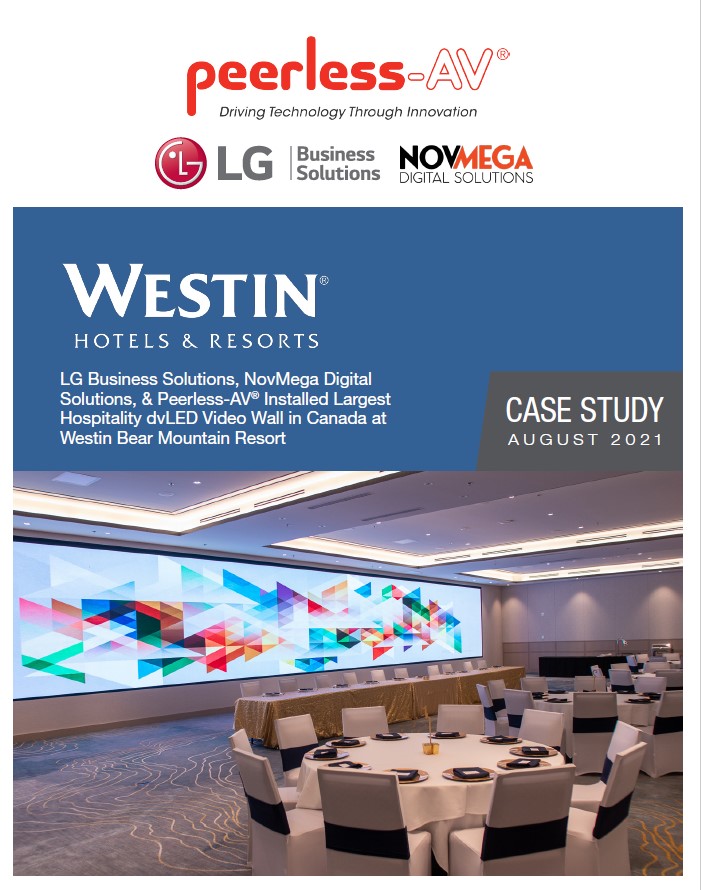Industry Insights: Opportunities for Digital Signage to Contribute to Public Safety
To all of us in the commercial audiovisual industry, digital signage has recently proven to be a critical part of our business strategy due to the COVID-19 pandemic. One which has forced a radical change in our business over the last year, as our collective customers have adapted to this new situation. Digital signage is one aspect of our business that has not necessarily declined or been delayed, unlike conference room or event-related projects.
It is now more critical than ever to inform and maintain safety in public spaces, regardless of whether we are talking about communications, monitoring, or security. What we as a community of AV integrators need to consider are the trends driving this opportunity, and some of the new tools that have evolved thanks to those trends, that ultimately can provide much needed opportunities during this crisis. Let us examine five key trends and the kinds of products that relate to them that we all can take advantage of.
The obvious elephant in the room is the fact that we must recognize the shift in business away from what we traditionally focused on within AV (like conference room systems) has had to change. Most companies aren’t investing in those sorts of solutions, when users aren’t actually using them! I’d also suggest that many companies may reevaluate spending on large offices … working from home is proving productive and cost effective for many. However, that does not mean a potential loss in business for our industry, just a shift in focus, as I spoke about previously.
The changes we have had to face to continue to operate during COVID-19 are creating a unique set of needs for our customers that AV technologies can adapt to address:
- Access control based on detected health and public safety.
- Physical traffic management, limiting occupancy of public spaces and controlling flow of movement.
- Compliance detection to track mask usage and physical distancing.
- Public health monitoring through temperature sensing and safety questions for contact tracing.
- Educating and informing the public of the most up to date science, proper protocols and procedures, even available services.
- Self-service wherever possible to limit exposure.
This is good news! These needs are sharply driving new trends in technology adoption:
- A new global focus on healthcare facilities.
- Strict requirements for increased cleaning and maintenance of all public-facing technology.
- A desire for touchless interaction whenever possible.
- The further integration of mobile devices into our daily lives.
- Wireless pay being used much more frequently.
- Tracking of mobile device users via beacon and Wi-Fi.
- Communication of critical information, and increased business interaction.
This ultimately translates into an accelerated merging of digital signage, surveillance, security, and IoT technologies into a new set of unified solutions, at a much faster rate than anyone would have expected.
One of the easily understood trends is the adoption of outdoor digital signage displays. This was already happening, but at a slower pace. Would the new saying perhaps become “The virus is the mother of all invention”? On second thought… maybe not. However, my poor jokes aside, this is a legitimate shift in spending by many organizations. The most obvious uses are in healthcare – information being displayed outside of facilities that can be updated in real time, without direct physical interaction are invaluable here.
Quick service restaurants (QSRS) were already making the transition to digital menu boards, this has just sped up projects. QSRs have had to adapt from much of their business being in the drive through, to ALL of their business being there… this makes digital menus here an obvious investment, and a way to recapture the upsell they may have had for dine-in customers. This goes further into retail, spending money on displays that are experiential in nature isn’t a good investment when people aren’t shopping recreationally, but either limiting time in store or picking up at the curb. Being able to see if a store has product in stock BEFORE waiting in line for entry is something, I think I can say I personally appreciate as a consumer. This is a natural opportunity that is a consequence of our current situation.
The next major trend is one we did not predict, but we are in a unique position to assist with. One of the things many of us have adapted to is having our temperature taken. This necessitates a person with a thermometer, which leads to increased exposure for all - so an immediate new product developed to help address this was the automated temperature check station. With a non-contact thermometer and a display to show you where to stand, as well as your result, this helps speed entrance while keeping people safer.
Now, that may not seem like the most “AV centric” of projects, but consider how that will need to further integrate, or may be integrated, into building systems. How many of us have access control in our offices? You scan a badge for entry? Consider plugging the temperature check into that – you have a fever? No entry! Also, adding large format digital signage into the mix – you can display entry protocol, remind both visitors and staff about safety, and provide any important information as part of this solution. This kind of physical entry management is likely to become the norm to limit future outbreaks.
Another trend that is an equally important safety tool is compliance monitoring. We have long dealt with cameras and surveillance as part of our business, but here it further integrates with digital signage, as well as bringing in various IoT type sensors. We can utilize cameras for verifying mask wearing compliance, with signage and audio warnings to those not properly practicing protocol, this could even further tie into the access control we just talked about! We can also use those cameras to detect physical distancing. We have long had tools to detect presence, but now we can provide more accurate traffic counting, to help us limit and manage occupancy. There are even solutions out there that tie into phone applications to help provide personalized alerts, or track users based on beacons or Wi-Fi usage.
Phones bring up the next big trend… phones! Now, before you get after me for being obvious, clearly I’m aware of the proliferation of mobile devices, and what that had previously meant to our industry. But that translates directly into greater adoption in new ways. First, this has dramatically increased the use of touchless payment (I’ve used my smart watch a few times myself… nice not having to pull my phone out of my pocket!) across all verticals – no one wants a cashier to handle a card, and no cashier wants to handle cash anymore, no matter what sanitation EITHER type of tender goes through.
We’re all also using ordering apps much more frequently (I’m not going to judge you based on your GrubHub purchase history, promise!), but this has also accounted for this sort of tool being used more broadly. A mobile app can replace a face-to-face interaction. That is inherently safer. I can now use a smart locker system to allow a retailer to place my purchases into a secure locker, that I use my phone to unlock, which is safer for all involved. We can utilize beacons or Wi-Fi tracking to help aid contact tracing, and this can be further enhanced by tying the previously mentioned access control and temperature checking in. I step up, my temp is verified as safe, my access is granted, but my entry is tracked via my phone – and if I am exposed, or accidentally expose others, notifications can be much faster.
Also, I’ll stretch and add laptops in here (don’t yell at me!) because I want to forecast a change in our traditional business that will come out of the pandemic, and this was the best segue I had! I’d suggest that BYOD is going to become the absolute standard for conference and huddle spaces – no one is going to want to touch technology that they aren’t SURE is clean. I bet this will also spur customer demand into voice control… but that’s another article. Sure, this is all a creative application of these technologies… but when has our industry NOT done that?? We were already having to master some of these disciplines and products, after all!
The final trend that I think is relevant will continue with the hybridization of multiple technologies that has helped drive everything discussed so far, videoconferencing! Of course, video communication was becoming common in the workplace far before COVID-19 hit us. We all were doing brisk business in UCC technology, but that’s not digital signage! Two-way video communication as part of digital signage (what we used to call things like the video concierge, historically) is another important aspect of how we can provide technology to assist our customers. Consider walking up to a self-service kiosk to order a meal, to-go. You have questions or run into an issue. Do you want to interface with a member of staff, potentially exposing both of you? Or would it be better to have a button for a video call, where you can ask for help through the kiosk? That also means that the worker who answers your call may also be remotely working. Everyone wins in this case. I think we are only beginning to see how far this one can reach, and how much it will stay around after this is all over!
Hopefully, the five trends (and the types of products that we can use to address them!) that I have shared with you here will help show that there is still opportunity for all of us, despite the changes that the pandemic forced us to make. There is still a light at the end of the tunnel, and our industry has always been a resilient one, going through so many paradigm shifts over the years… we have always adapted, and overcome. COVID-19 is no different, for those who want to think a bit outside the box, adopt some aspects of technology that may not have been part of our core competencies previously, and look ahead to what we CAN do, instead of dwelling on what we CAN’T.






